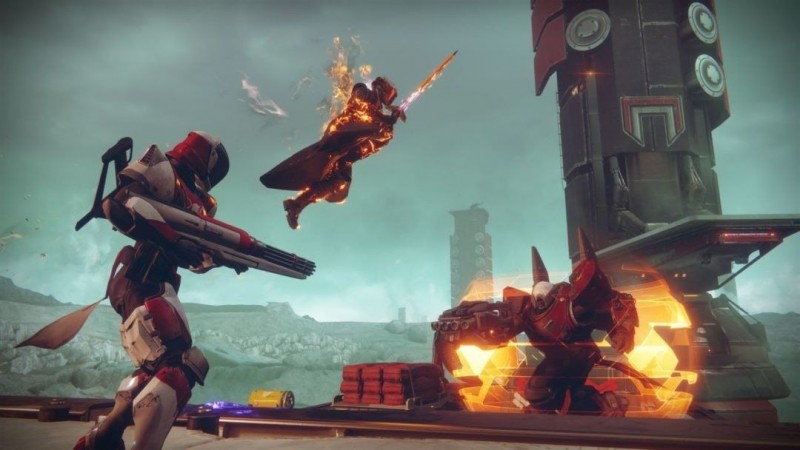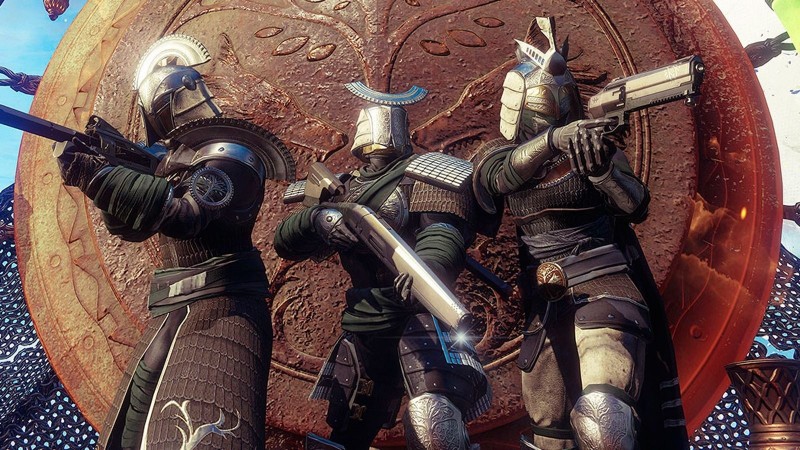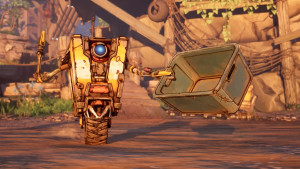Destiny 2 – The Season Two Report Card

Destiny 2 is a living game that is constantly changing. In addition to its major expansions, Bungie is regularly updating, patching, and otherwise tweaking the ins and outs of the play experience, and dedicated players are quick to note how even the smallest change affects their time in-game. As Season Three is about to launch alongside the Warmind expansion, I want to take the opportunity to look back at Season 2, which began with the launch of Curse of Osiris back in December, and comes to an end today.
Before looking at specifics, there’s some important things to consider. This isn’t a review of the full game, or of every aspect of play. My original review of Destiny 2 explores a look at the game very shortly after launch, and represents what players encountered in those early weeks – that is, a strong campaign, numerous strikes, a raid, and competitive Crucible opportunities, adding up to several dozen hours of fun and leveling. The picture became significantly more nuanced with a Season One report card. That article speaks to the game several weeks later, as some of the dilemmas around long-term play had begun to affect its most dedicated players. A subsequent review of the first expansion, Curse of Osiris, cited increasing problems in core aspects of competitive play, long-term engagement, the collection experience, and more, and noted increasing frustration from a voracious community.
Cut to several months later, and Destiny 2 feels like it’s in a precarious position. In the days since Curse of Osiris launched, Bungie has revised several aspects of play, but is also struggling with a dearth of players that is evident to anyone who logs in and examines their clan roster. Several core systems feel like they’re not built for the kind of investment experience that many serious fans want over half a year after the core game launched.
Simultaneously, Bungie has dramatically adjusted its approach to communication with its community, offering a clear roadmap of upcoming features that is regularly adjusted as schedules shift, which is a welcome change.
Where is Destiny 2 at as this second season comes to a close? And where are the opportunities for the game to see improvement as we head into season three, which begins tomorrow?

The Big Picture
Increasingly, two dilemmas stand out in the ongoing Destiny 2 play experience as it is experienced by dedicated players.
First, with each passing month, I struggle to understand the choice to abandon the wealth of locales, weapons, and adventures that unfolded in the three years of the original Destiny. Destiny 2 was built as a new system (rather than an addition to the old), in part to entrance new players and give veterans something new to chase, but also likely because it allowed Bungie a clean slate to redesign how the game was put together on a technical level. To its credit, the sense of newness did genuinely help Destiny 2 to shine at launch, and several systems felt better as a result, including planetary discovery and exploration, clan integration, and a more logical and understandable approach to gear acquisition, among other things. And, sure enough, the game activities and locations did indeed feel fresh and exciting at first, and brought many new players into the fold who were frightened off by the original Destiny’s sometimes cryptic systems.
Unfortunately, several months in, new locales and missions on places like Io and Titan don’t feel any fresher or more engaging than a patrol mission might on the old stomping grounds of Mars or Venus. In fact, I miss the variety that came through a return trip to places like the Dreadnought, or even patrols on the Moon. On a thematic level, Destiny speaks about humankind rediscovering its past and flexing out into an ever-widening universe; it feels strange that as Season Two comes to a close, Destiny 2 still feels like a smaller universe than what was on offer in the original game.
The second dilemma is about where and when in the arc of a player’s journey through the game that they could expect to find the most fun. I don’t think it’s a coincidence that critics and community alike had consistently high praise for the initial launch of Destiny 2 (especially compared to the initial launch of the first Destiny game back in 2014), but that same community has struggled to find meaning and engagement in these later months of Destiny 2. Many of the design decisions that shaped Destiny 2 frontloaded the exciting battles, growth, and storytelling into the first several dozen hours, but it came at the cost of opportunities for depth further in.
Most players I know had a really good time early on with many of the new systems. Static rolls on equipment meant that it was easier to chase that one weapon you wanted in the early weeks, but it also meant there was no reason to go after a better version later on. Team-focused, small-team competitive play in the Crucible was a lot of fun, especially for new players to feel capable, but later on the skill curve seemed to drop away, since there were fewer ways to chase one-on-one mastery over opponents. Many activities flattened the power level so that everyone could participate together, as we saw with events like Iron Banner and public events, but it meant that there were fewer reasons to strive and grind for those pinnacle power points on your character sheet.
For dedicated fans who are eager for a daily hobby, it’s easy to find fault in these decisions, but in many cases, it helped Destiny 2 jump to a strong gallop out of the starting gate. Unfortunately, these same decisions have meant that during Season 2, in particular, the horse feels like it is dragging. The long-term engagement problems are apparent, but Bungie hasn’t yet had the time it needs to address the bulk of the concerns. But it doesn’t mean that the developer hasn’t been trying.
Next Page: The painful crawl of Season 2, and the surprising bright spots along the way

Baby Steps
Five months is a long time in the life of a video game. That’s about how long Destiny 2 players have had to explore the nooks and crannies of Season 2, and by most measures, the experience has come up lacking, at least in the sense of offering reasons to log in and consistently engage with the universe.
The small new playspace offered by Curse of Osiris simply didn’t live up to expectations, and the potential for procedurally generated content promised by the Infinite Forest turned out far less compelling. Heroic adventures on Mercury were a bright point, as was the chase for the Lost Prophecy weapons; both provided opportunities for a longer tail of week-to-week play opportunities and some genuine challenge, but even those began to fall flat soon after, especially since those systems felt locked away in the walled garden of the Curse of Osiris-themed content, rather than implemented more broadly across the game.
The roll-out of masterwork legendary weapons and armor were welcome, but the minor improvements to my guardian offered by these systems haven’t yet justified the work that’s often required to get them. And even if I did, what content is sufficiently challenging and engaging to require that masterwork gear to be used? To put it another way, I’d love to drive a Ferrari, but what’s the point if all the roads I can drive it on have a 35 mph speed limit?
In short, I simply can’t find adequate reasons to log in on a daily basis, whether for the activities on offer, or the rewards I might get. But even as I feel frustrated about that, there’s no doubt that Bungie has been working hard to make some changes, and whether the players have logged back in or not, it’s beginning to make a difference to the game’s potential long-term appeal, even ahead of Season Three’s launch.
A significant change to the structure of nightfall strikes is a lot of fun, and I’m happy that there’s unique loot for those weekly strikes, even if the loot options themselves haven’t really blown me away. Likewise, new raid-specific mods on raid loot adds a little something new to chase, which I think is great, even if in my relatively broad circle of Destiny-playing friends, it’s been quite challenging to find enough people willing to jump in and pull together a raid.
Crucible play has also made some strides. I dug in and had a good bit of fun in the new 6v6 Iron Banner playlists, which brought back some of the intensity that seemed to be lacking in 4v4 sessions (which remain the chief option in most other playlists). Crucible play also has seen an uptick in power ammo recharge on the field, so there’s a lot more explosive weaponry showing up during a standard match. I’ve got mixed feelings about that, especially because it feels a bit like a band-aid to a weapon slot system that simply is in need of a more dramatic rework. At the very least, it does ratchet up the intensity of any given match. I can’t say I’ve fallen in love with the new “no radar” competitive playlist options quite yet, but it does change the dynamic in that more high-stakes game mode; anecdotally, I’ve heard a pretty even mix of people who like or don’t like this change, so more time may be required to see how it shakes out, especially as a new season rolls around, and the player population comes back up.
Nonetheless, a significant sandbox balance pass arrived for weapons and classes partway through the season, which has resulted in significantly more variety in both the weapons I get killed by and the subclasses that do the killing – that’s a good thing. In particular, I appreciate that auto rifles have remained strong, rather than suddenly being dramatically cut back in power. If that’s your favorite weapon class, you can still expect them to be an ideal go-to weapon type. But other weapon classes have seen buffs to help them stay competitive, which is the right philosophy to pursue: Make every weapon strong and exciting to use, rather than dramatically nerf the guns that are seeing the most use. In both PvE and PvP content, I see a broader spread of weapons in use, which is an indication of a healthy balance state. I also love that the Warlock Dawnblade has seen some meaningful improvement; I always love the concept of the subclass, but in practice she always felt underpowered. I’m happy that’s changed.
In short, I suspect lapsed players will be surprised that a number of features have already changed in the last few months. It’s just that they’ve been coming in piecemeal. With a new expansion, new season, and yet other substantial gameplay changes on the way in the coming days, Destiny 2 may still not be where every player wants it to be, but those small steps, in aggregate, may make a bigger difference than you might expect.

It’s All About Collecting
After so many months, the game is in desperate need of some new loot to chase. As Season 2 comes to a close, the reward system has some big problems that must be conquered.
First, the current pool of rewards simply doesn’t get me excited to chase. Many weapons are painfully similar to one another in the way they shoot, and despite some cool-looking armor, the pieces themselves don’t stand out for the way they might affect your playstyle. While this appears to be changing soon, as of the end of Season 2, too much of the cosmetic item pool is still rooted in the Eververse microtransaction system, which leaves a sour taste in my mouth, and prevents me from feeling motivated to try and get any of it, even if some of it might now be attainable through in-game activities. Finally, the exotic gear that so entranced me in the original Destiny often just doesn’t pack the oomph to keep me excited about using them. The promised buffs to exotics arriving with Season 3 are much needed to reinvigorate the enthusiasm for these most top tier rewards.
Second, the collection experience continues to wear the concrete shoes of painfully inadequate vault and inventory system. I articulated a lot of this in a separate dedicated article several months ago, and most of the most serious problems remain today. The vault is too small to collect and keep full sets of all the legendary gear, so there’s a constant need to delete and make new space. The single-use shader system simply doesn’t have enough space in the inventory to hold all the different shaders. Likewise, a similar problem persists with the mods. And the whole thing is lacking in clear avenues for organization.
Taken together, the lackluster current rewards and the shortcomings of the vault system add up to an experience that simply isn’t a lot of fun for collection-oriented players. I’m actually disincentivized to log in, because I know I’ll have to spend 20 minutes clearing out my postmaster from the last time I played, and making the frustrating choice between deleting a stack of shaders, or getting rid of that Iron Banner gun I spent so long grinding to get.
One positive note on the collection experience that I don’t want to leave out is the change to vendors and the token economy that went in shortly after Curse of Osiris went live. Balancing the need to do some grinding first with the player’s desire to eventually get a full set of armor, most vendors now offer a system where you can still rank up for random rewards, but after a certain number of turned-in tokens, also simply buy the desired equipment outright. I applaud that system, even if by the time it was implemented, most hobbyist players had already gotten the pieces they might want. It will be a much more meaningful option as new armor and weapons enter the sandbox in the coming weeks and months.
Next Page: The complicated relationship between Bungie and its community

Changing Hearts and Minds
Investment-focused social games like Destiny 2 rely heavily on the good will of the community that plays the game. And while recent weeks have seen the tenor shift slightly, it’s safe to say that Season 2 was dominated by frustration, vitriol, and outright abandonment from many of its most active players, and delicate work is needed to bring folks back into the fold.
Bungie has made positive steps in this regard. More open and regular communication from the development team in blog posts, videos, and other avenues helps to put a face to the developers making the game, and I hope it’s a trend that continues. A recent community summit at the studio offered a chance for some well known members of the Destiny community to interact directly with the developers at their studio. And a regularly updated roadmap offers an at-a-glance understanding of how Destiny 2 is changing in the future, at least to some degree.
When talking about large triple-A video games, I’ve often used the metaphor of a big ship that takes a long time to turn, and when considering Bungie and the Destiny franchise, that comparison has often been apt. Interestingly, it’s also a metaphor that works the other way as well – a game community like the one that follows Destiny 2 is slow to change direction. The recent trajectory for that community has been toward negativity, even as Bungie has been working to make changes to address the most serious concerns. After so much hand-wringing during Season 2 about the state of the game, is that community even capable of changing gears to be positive and enthusiastic again, even if Season 3 heads in the right direction? Or will the changes Bungie is making not be enough? Time will tell.

What Lies Ahead
Many of the concerns and opinions expressed in this article are about to become out-of-date. Season Three is promising significant changes to Destiny 2, along with a bunch of new content to play and rewards to chase.
However, I was struck as I considered the full breadth of Season Two that it’s been a more active several months than I suspect many fans might have sensed. Rather than one big splash, Destiny 2 has seen a number of small adjustments and additions since December. And here’s the thing: Most of them have been quite good. From the nightfall changes, to the 6v6 Iron Banner, to the balance adjustments to weapons, I’m mostly happy about the choices Bungie has been making to improve the game. Even so, core systems like a problematic vault, a weapon slot system that is not aging well, and limited activities that attract high-level play are all big issues that remain on the table – and I don’t suspect all of those to be fully solved by Season Three and the impending launch of Warmind.
Nonetheless, the strides made toward a better game have me optimistic that Destiny 2 still has life in it. And with little competition from similar styles of games, there's still an audience that could be eager to engage once again with the game, if concerns are addressed. When considered alongside the life cycle of the original Destiny, I think it’s fair to say that Season Two of Destiny 2 has been a relative low point for the series, but it has also been a time where we’ve seen some seeds planted that may indicate big things to come. I count myself among the many fans who are still eager to see the franchise be at its best, even if it takes some patience from both the fans and the developers as both sides look for the best path forward.






